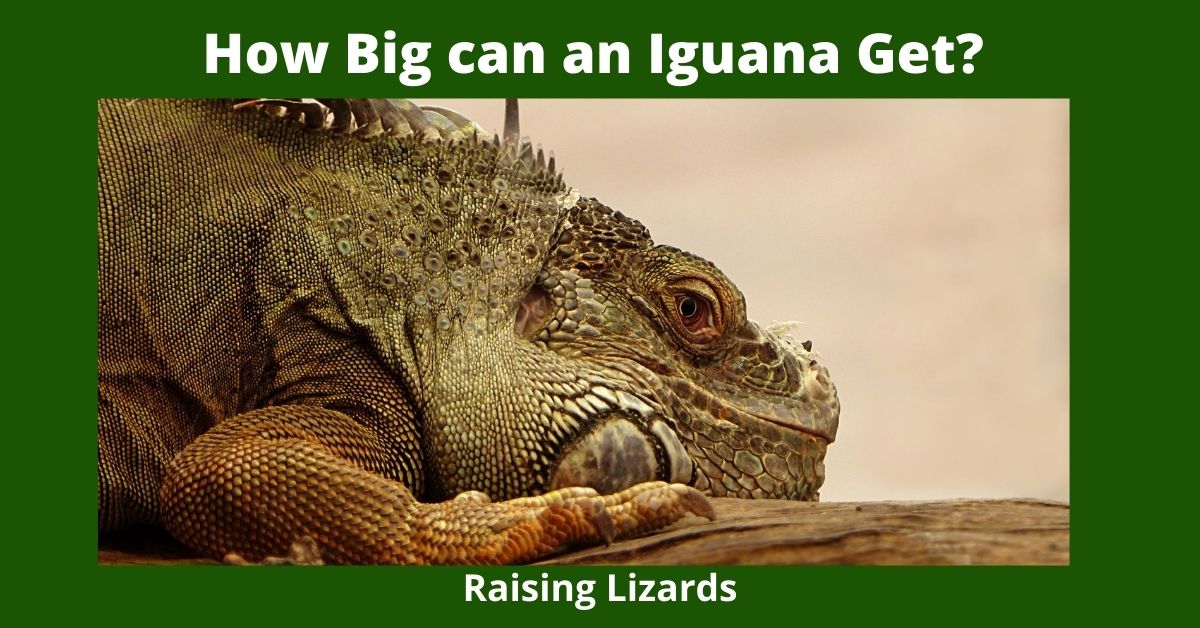A Mature Iguana can get to over 6 Feet Long, weigh over 30lbs, They have a lifespan of approx 20 Years.
How Big can an Iguana Get?
Iguanas are a type of large lizard that can grow up to six feet long. Most iguanas on the market today are somewhere between two and three feet in length, with females averaging slightly larger than males. In captivity, some have been known to reach lengths over four feet. Wild iguanas tend to be smaller on average because they spend more time hunting for food instead of eating from humans’ trash piles or having their meals served ready-to-eat in bowls.
Where do Iguanas Originate from?
Iguanas are native to Central and South America, but they have been introduced to other parts of the world as well. Iguanas can be found in many different colors, including green, blue, red, orange, black, and yellow. They grow up to six feet long and weigh around 15 pounds. Iguanas are herbivores and eat a variety of plants. They also like to swim and can stay underwater for up to 30 minutes. Iguanas can live up to 20 years in captivity, but only about five years in the wild. How Big can an Iguana Get? Jump to 7 Reasons to Have a Pet Iguana

What Does the Name Iguana Mean?
The name iguana is derived from the Mayan word ikwana. The Mayans were one of the first cultures to encounter these lizards. Iguanas are popular pets, and there are both wild and captive-bred species available in a variety of colors. They can live for up to 20 years in captivity but only five years in the wild.
Iguana Habitat
Iguanas can be found near water in tropical environments where they bask in the sun to regulate their body temperature. Iguanas use their long tails for balance when climbing trees and can swim well too. They eat a variety of plants, including fruits, flowers, leaves, and vines. Captive iguanas may enjoy eating vegetables like broccoli, leaf lettuce, and zucchini.
Iguana Behavior
Iguanas are generally docile creatures but can be aggressive when threatened. They often communicate with each other through a series of chirps, barks, and growls.
Iguanas will sunbathe to regulate their body temperature and can stay underwater for up to 30 minutes. Captive iguanas may enjoy taking baths in water dishes or swimming in bathtubs. Iguanas bask in the sun to regulate their body temperture and eat a variety of plants.
There are several different types of iguanas, including the:
Green iguana-Green iguanas are native to Central and South America.
Blue Iguana-The blue iguana is a reptile that originates from the island of Madagascar off the coast of Africa. It can grow up to four feet long and weigh around 20 pounds in captivity, but these lizards only reach about half this size in the wild. The lizard’s body color ranges from bright green to dark brown with some individuals also having black stripes on their bodies.. Blue Iguanas have small claws so they cannot climb trees like other types of large lizards such as anoles or chameleons do. To protect themselves, blue Iguanas use speed rather than strength when fleeing predators by running away at speeds over 15 mph (25 km/h).
Red Iguana-The red iguana is a lizard found in Central America and parts of South America. These lizards can grow up to six feet long, weigh over 30 pounds, and live for up to 20 years in captivity. They are usually a reddish color with green or black markings.
Orange Iguanas-Orange iguanas are native to the island of Hispaniola in the Caribbean. They can be identified by their orange color with some having black markings. These lizards reach an average length of two feet and weigh about five pounds.
Black Iguana-The black iguana is a lizard found on the island of Curacao, which is located in the Caribbean. These lizards can be identified by their black color with some having green markings. They reach an average length of two feet and weigh about five pounds.
Yellow Iguanas-The yellow iguana is a lizard found in Central America and parts of South America. These lizards can grow up to six feet long, weigh over 30 pounds, and live for up to 20 years in captivity. They are usually a light yellow color with green markings.
Spiny-tailed iguana -The spiny-tailed iguana is a lizard found in the dry forests of Mexico, Central America, and South America. These lizards can grow up to four feet long, weigh up to 25 pounds, and live for up to 15 years in captivity. They are usually a green or brown color with some having black markings.
Rock Iguana-Rock iguanas are lizards found on the islands of Bermuda, Grand Cayman, and Jamaica. These lizards can grow up to four feet long, weigh over 25 pounds, and live for up to 15 years in captivity. They are usually a green or brown color with some having black markings.
Central American Iguana-Central American Iguanas are a species of iguana found in Central America. These lizards can grow up to four feet long, weigh over 25 pounds, and live for up to 15 years in captivity. They are usually a green or brown color with some having black markings.
Desert Iguana-The desert iguana is a lizard found in the North American deserts. These lizards can grow up to two feet long, weigh up to five pounds, and live for up to 15 years in captivity. They are usually a tan or light green color with some having black markings.
Galapagos Land Iguana-The Galapagos land iguana is a lizard found on the islands of Santa Cruz and Isabela in the Pacific Ocean. These lizards can grow up to three feet long, weigh about five pounds, and live for up to 15 years in captivity. They are usually a tan or light green color with some having black markings.
Iguana Classification is
- Family-Iguanidae
- Order-Squamata
- Suborder-Sauria
- Infraorder-Iguania
What is the Lifecycle of an Iguana?
- Egg – An iguana’s life begins with a single egg, produced by the female. The eggs are laid in clutches of up to 40 eggs, and hatch within 70 days from laying. At first only about one inch long (25 mm), green tree iguanas grow quickly after hatching—at an average rate of 0.188 inches (0.47 cm) per day for the first year, and about 0.09 inches (0.22 cm) a week after that.
- Nursery – Iguanas hatchlings live in a nursery group with their mothers and other juveniles until they are about four months old. This helps protect them from predators and allows the mother to forage for food. Juveniles learn important survival skills during this time, such as how to find food and avoid danger.
- Adult – Once the juvenile iguanas are four months old, they move out of their nursery group. They continue to live in groups until they reach sexual maturity—about three years for females and five or six years for males. Green tree iguana males often fight each other over territory ownership after reaching maturity.

Factors that determine an Iguanas size?
The size of an iguana is determined by a number of factors, including the age and sex of the iguana, as well as its genetics.
Male iguanas are typically larger than female iguanas, with the average male reaching lengths of up to five feet long, while females usually top out at around four feet in length.
Young iguanas also tend to be smaller than adults, with hatchlings measuring just a few inches in length. Some species of small lizard can actually reach similar sizes to baby iguanas, but most other lizards only grow to be a fraction of the size of an adult iguana.
Iguana size is also largely determined by their environment; animals that live in warmer climates tend to grow bigger than iguanas that live in colder regions.
Do Iguanas Tails Come Off?
Well, as it turns out, iguanas can lose their tails under certain circumstances. This typically happens when they are threatened by predators or when they are in pain. In fact, about 15% of all iguanas will lose their tails at some point in their lives.
While losing your tail may not seem like a big deal, it can actually be quite dangerous for an iguana. Without its tail, an iguana is much more susceptible to becoming preyed upon. Additionally, without its tail, an iguana is unable to balance itself properly.
Fortunately, most iguanas who lose their tails are able to grow new ones within a period of several months (or even weeks). This happens because the tissue in an iguana’s tail is actually quite similar to that found on its head and neck. Because these areas are so closely related, it becomes possible for the same tissue to grow in different places.
However, some iguanas are unable to regrow their tails after they have been lost. This is because an injury may have severed important blood vessels that provide nutrients and energy to the area where a tail would typically occur. If these resources can’t reach a damaged region of flesh (or bone), it becomes impossible for new tissues to form there.
Unfortunately, this means that many injured iguanas will be forced spend the rest of their lives without any sort of tail!
What Are Natural Predators for Iguanas?
The natural predators for iguanas are many and varied. They include snakes, birds of prey, large lizards, and feral cats. In the wild, iguanas have to constantly watch out for these predators while they are trying to eat, drink, or find a place to hide.
One of the biggest threats to iguanas is the American alligator. These reptiles can grow up to 14 feet long and weigh more than 1000 pounds. Alligators will often attack young or injured iguanas, as well as those that are stranded on land.
Other common predators of iguanas include hawks, owls, raccoons, coyotes, and bobcats. Cats in particular pose a threat to iguanas while they are in their burrows because the cats can dig up iguana holes and drag them out.
However, there is a silver lining to this dark cloud of predators for iguanas: humans! Humans often kill iguanas for food or as pests on farms. In addition, it’s not uncommon for people who live near ponds to trap and relocate wild Iguanas that come onto their property. This helps keep down the populations of these invasive reptiles.

Final Thoughts – How Big can an Iguana Get?
In summary, the type and sex determine the size and genetics of an iguana, diet climate, and health. Iguanas can get as big as a human, but the average is about six feet long. The predators for an iguana are varied and many. They have to worry about feral cats, snakes, hawks, owls, raccoons, coyotes, and bobcats. Humans pose a large threat to them due to hunting and trapping;


